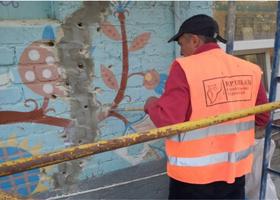
Contact with Technologist01
You leave a request, our Technologist will contact you. We receive a technical problem from you.

Cutting off the capillary rise of moisture



Capillary rise is the rise of moisture from the ground through the capillaries of walls (on the photo, this path is depicted by an arrow with the number 1).
Moisture, rising from the ground, reaches the level of the first floor and brings with it the discomfort described above.
Protection against capillary rise of moisture should be addressed during the construction stage by performing horizontal waterproofing, as shown in the photo.
According to all existing norms, the performance of horizontal waterproofing is mandatory.
However, unfortunately, very often during new construction, it is not done or is done insufficiently professionally.
Or, if we are talking about an old building, such waterproofing may have been performed, but it has been destroyed over time.


Drilling holes in the brickwork, blowing compressed air.
Injection of a special waterproofing composition into the holes.
Waiting for the holes to dry with a repair solution.
Application of waterproofing over a series of injection holes.

solve this problem.






Effectively solves the problem of damp walls
Can be done quickly without extensive repair work
The results will be noticeable in the near future
Capillary moisture isolation is maintained for decades
The work can be carried out at any time of the year regardless of the ambient temperature
Significant savings in material and labor costs as this method does not require excavation work

You leave a request, our Technologist will contact you. We receive a technical problem from you.

We develop a TECHNOLOGY to solve your problem, select materials, prepare an estimate.

We organize the prompt delivery of the necessary materials to your object. If necessary, we provide training or installation supervision.

If you order a 'TURNKEY' service, we will organize the execution of work according to the developed TECHNOLOGY and all applicable regulations.

No, not exactly. Because the moisture can enter the room through at least four different paths (mapping by arrows on the drawing).
Therefore, in order to avoid mistakes and unnecessary costs, it is necessary to conduct a survey and accurately determine which of the paths we are dealing with at a particur facility.
You can contact our specialists, send photos/videos of your situation. We will professionally determine the heart of the problem and propose a technology for its solution.